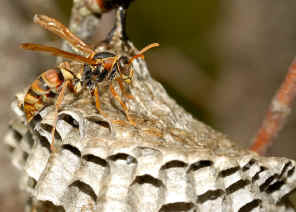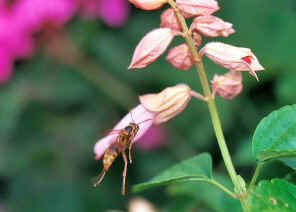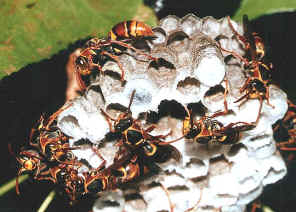Common Large Paper Wasp, Australian Paper Wasp - Polistes variabilis
FAMILY VESPIDAE
This page contains pictures and information about Common Large Paper Wasps that we found in the Brisbane area, Queensland, Australia.

- Insects body length 20mm
Paper Wasps build wide cone shape nest hanging with single stalk. They are social wasps living in colonies in a nest built of "paper". Those nest building materials are chewed plant materials such as decayed timber, mixed with their saliva. They will attack and sting if their nest are disturbed.



-
- Paper Wasps have a yearly cycle of their life. In spring season a Paper Wasp female starts building its nest. She will be the queen if her colony can be established. Paper Wasps build nest under sheltered area, such as under palm leaf, large tree trunk and building covers. The second picture shows the same nest, which becomes a established colony in mid-summer.



- Paperwasps, like all ants and some bees, are social insects, each nest is a colony of females. Only one female, the queen, lays all the eggs. All the other females are workers, they help their mother queen for feeding their sisters. They also help in building and expanding the nest. They can sting painfully and will defends their nest aggressively.
- Unlike bees or ants which the queen look very different. The Paper Wasp queen just look similar to all her workers. The queen lays an egg in the bottom of each cell. When the wasp larvae hatch, their adult sisters feed them with chewed caterpillars and some other insects. When the larvae fully grows and becomes a pupa, the cell is closed. Some time later a new adult wasps emerge and it become a new worker of the colony. The wasp colony gradually expands and establishes.



- At the end of the summer season, the colony produces male and fertile female wasps. They mate with the males and fertile females from other colonies. The fertile females then hind in some place to pass the winter. They will start their own colony in the next spring season.



- Paper Wasps build wasp in all different area. The usually build nest in sheltered position, under board plum leave, beneath branches and buildings. Their nest can be up to 200mm across contains hundreds of insects.



- In the above picture (middle), notice the different stages of the young development, includes the egg, larva and pupa. Also notice how the adults attend the young.
Starting a Colony



- The eggs laying wasp started the colony alone. Later a few young matured and become workers and help to look after their mother to look after their young sisters.





- From appearances it is difficult to tell apart the queen and the workers.
Feeding on Flowers



- Adult Paper Wasps feed on nectar and pollen so we sometimes see Paper Wasps visiting flowers. However they spend most of their time searching amongst plants for caterpillars and insects, which their young sisters feed on. We can also see them visit the water pots quite often for they need water to to mixed with the plants materials to build the paper nest.
Collecting Water


Looking for Prey



- Workers forage food, i.e., caterpillars and some other soft body insects to feed the larvae in the nest. Adult wasps feed on nectar from flowers.









A Paper Wasp Worker Found a Large Caterpillar
In a early summer afternoon, we saw a Paper Wasp worker found a large caterpillar among the flowers. The caterpillar was creamy-white in colour with a blue-green head, look like a Skipper Butterfly larva. The caterpillar was too heavy for the wasp to carry away.



- The wasp pull the caterpillar to the top of a flower bud and start to cut its body with her sharp mouthparts. We noticed that that caterpillar was dead and part of its body was missing. This indicated that this may be the second time the wasp came back to the caterpillar, or other insect/wasp may have found and cut the caterpillar first.



- The wasp cut a large piece from the caterpillar and carefully pack it into ball shape for easy carrying. Then she started to fly back home to feed their larvae. We noticed that the wasp circle around over the caterpillar body a few time before she disappear. We believed she did that to recognize the location so that she could come back after deliver the meal.



- Notice the cells are developed together with the larvae. The newly built cells on the edge of the nest contains newly laid egg. They fully built cells contains large larvae. Those closed cells are pupated larvae.


Paper Nests
- Reference:
- 1. Wildlife of Greater Brisbane - Queensland Museum 1995, p114.
- 2. paper wasp, Polistes variabilis (Fabricius, 1781) - Insect images, 2010.
- 3. The Australian social wasps (Hymenoptera : Vespidae) - Richards, OW (1978), Australian Journal of Zoology Supplementary Series 26 , 1–132.



